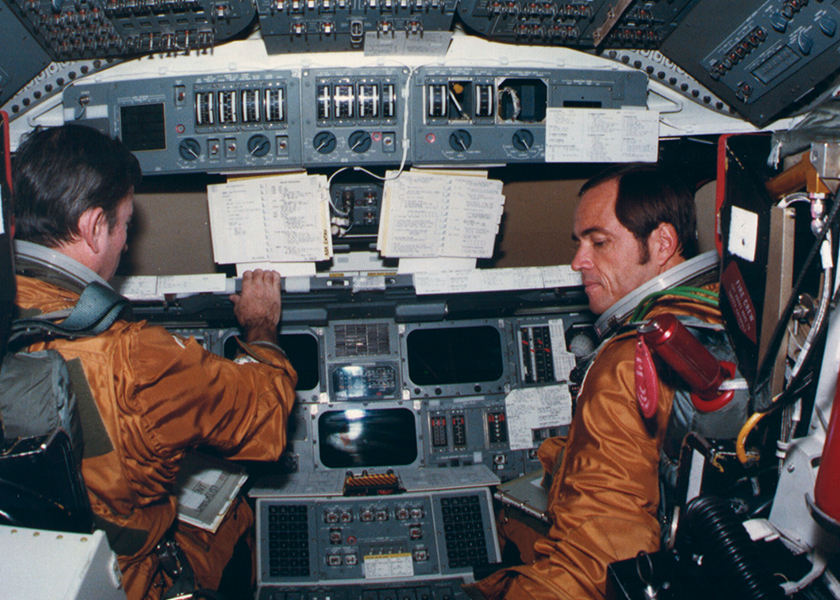Stay Up to Date
Submit your email address to receive the latest industry and Aerospace America news.
It would be a mistake to rush a crew aboard untried NASA vehicles
Put a pair of astronauts atop a brand-new booster with more takeoff thrust than the Saturn 5, strapped into a spacecraft with an unflown life support and propulsion system, and hurl them around the moon. What could go wrong?
Yet NASA is examining, at the request of the Trump administration, the feasibility of flying astronauts on the initial flight of the Space Launch System rocket now targeted for late 2018. Although it’s certainly a bold idea, it’s a risky gamble whose benefits don’t warrant risking a crew and NASA’s exploration future on an untried rocket and spacecraft.
NASA has been properly noncommittal on the idea of committing astronauts to SLS’s first flight. It is, after all, a mammoth booster generating 8.8 million pounds of liftoff thrust to put 70 metric tons into low Earth orbit (where any flight to the moon or beyond would begin). NASA has said only that after discussions with the new administration, it is studying what opportunities “crew on first SLS” offers, and what it would take to accomplish the first step of pushing humans farther into space.
The approach would be a radical departure from existing plans that call for an SLS to boost an unpiloted Orion spacecraft into a distant retrograde lunar orbit, a flight termed Exploration Mission 1, or EM-1. The next SLS launch, EM-2, would be the first with people aboard. A crew would circumnavigate the moon sometime in 2021.
The up side
Swinging around the moon close to the 50th anniversary of Apollo 11’s first lunar landing, a crew on EM-1 would speed America’s lunar return by at least two years. And this spectacular lunar circumnavigation would, of course, occur during the Trump administration’s first term, in marked contrast to the slow pace of human exploration under the last president, who after canceling lunar return plans in 2010, slow-walked the development of both SLS and Orion.
Putting a crew on EM-1 would engage that billion-dollar-class SLS (depicted on a launchpad in the artist’s rendering at the top of this article) in productive work immediately, advancing plans for a full lunar orbit mission, a possible return to the lunar surface, and eventual sorties to nearby asteroids and Mars. Jumping out of the blocks with a crew aboard the very first SLS would underline like nothing else a robust American commitment to human space exploration.
Risks
The first flight of any rocket inevitably carries more risk. Ground tests don’t fully replicate flight conditions, and even proven rockets still break. The most advanced computational techniques cannot guarantee that a complex system on its first launch will perform as designed. An unpiloted test flight gives designers, controllers and managers a chance to learn invaluable lessons about their machine, and fix problems before risking human life.
NASA launched its boosters for the Mercury, Gemini and Apollo programs several times each without astronauts to prove their reliability. Apollo’s Saturn 5 exhibited serious problems on its second unmanned launch, but NASA fixed them convincingly in time for Apollo 8, the first crewed lunar mission.
The shuttle, it’s true, had John Young and Bob Crippen at the controls on its first launch, STS-1 in 1981, but only because the hybrid booster-spaceplane required flight with humans in the loop.
Unpleasant surprises on STS-1 nearly doomed that courageous duo. A reflected acoustic wave off the launch pad from booster ignition inflicted structural damage on the orbiter. The same overpressure deflected the body flap — a vital hypersonic control surface — well beyond its flight range, risking critical damage to the hydraulic aero control system. Sixteen heat shield tiles were lost during ascent. And a badly installed heat shield tile allowed hot gases to buckle the door protecting Columbia’s right main landing gear.
Only the safety margins built into the hydraulic and landing gear systems — plus luck — saved the orbiter and crew. STS-1 proved that a crew should not fly an untested vehicle unless driven by absolute operational need. Columbia commander Young often told us in the astronaut corps: “One test is worth a thousand analyses.”
Flying a crew on EM-1 would be a tall order for NASA, SLS and Orion. SLS awaits structural testing and a full-up, ground firing of all four core-stage RS-25 engines. To fly a crew, SLS’s second stage, the new Cryogenic Propulsion Stage, must be human-rated, a process not envisioned for EM-1.
Orion’s launch abort system must still pass a high-altitude launch abort test. NASA would have to add to EM-1 a life support system and crew displays and controls, originally planned for EM-2. These tests and additions will consume too much money and time, negating any benefits from flying a crew on the first flight. NASA would do better to fly EM-1 unpiloted as planned, learn the flight’s many lessons, and give astronauts a proven, well-understood EM-2 machine. That second flight could then take place as early as 2020.
We learned after Challenger’s tragic 1986 loss that the right approach to spaceflight is not “show me that it’s unsafe to launch,” but “prove the machine is safe to fly.” The latter approach is just as right-minded today as it was when proven — at agonizing cost — three decades ago.
About Tom Jones
Tom flew on four space shuttle missions, including his last flight, STS-98, in which he led three spacewalks to install the American Destiny laboratory on the International Space Station. Tom is a senior research scientist at the Florida Institute for Human and Machine Cognition.
Related Posts
Stay Up to Date
Submit your email address to receive the latest industry and Aerospace America news.





